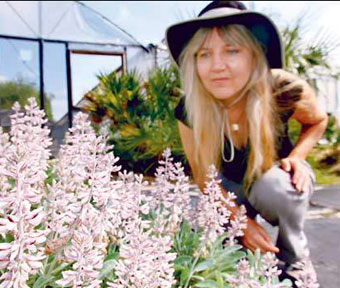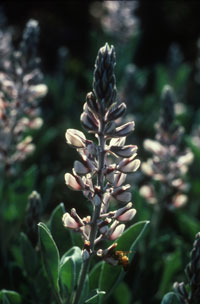Human Flower Project
Thursday, March 23, 2006
Coddling Florida’s Lupine
Despite bulldozers and hurricanes, a Florida sanctuary nurses McFarlin’s lupine into bloom.

Cheryl Peterson, conservationist, oversees McFarlin’s Lupine,
now in rare bloom at a Central Florida sanctuary.
Photo: Pierre Ducharme, for The Ledger
Pass out the cigars!
The Historic Bok Sanctuary in Lake Wales, Florida, announces the flowering of an endangered native species, McFarland’s lupine. The lovely pink and maroon blooms of Lupinus westianus var. aridorum are cause for celebration, perhaps even a bit of unabashed breast-beating. This plant is nearly extinct. It’s one of 39 species that botanists at Bok have been toiling for years to save.
Reporter Tom Palmer of The Ledger (Lakeland, FL) broke the news of this near-miraculous success.
“The plants are impossible to grow from transplants or cuttings, and they won’t grow in flower pots. Instead, they require a bed of native soil from the site where they grew and then, if all goes well, the seeds will germinate.
“‘The seeds were part of a plant rescue in Orange County where they were expanding the turnpike,’ (conservation program Manager Cheryl) Peterson said. ‘We got 24 seeds.’”
Horticulturists at the Bok Sanctuary planted all the seeds three years ago; only five germinated. Then, in 2004, Hurricane Charley blew in, killing three of the seedlings.
“One of the two plants that survived is quite a specimen—3 feet across with more than 60 blossoms.” The Bok conservationists hope (that’s putting it lightly) it will produce enough seed to replant here and spread to other locations in its native habitat—central Florida.
 Lupinus westianus var aridorum
Lupinus westianus var aridorum
Photo: Center for Plant Conservation
Lupinus aridorum “was first collected by Meislahn in 1900 in Orange County, Florida.” In 1928 and 1937 James Brigham McFarlin collected the plant in his native Polk County, home of the Bok Sanctuary, too.
Over the years, Bok staffers have seen the interest in endangered plants strengthen, one reason they’ve spread the word about this spring’s success with McFarlin’s lupine. Bok is affiliated with the Center for Plant Conservation in St. Louis, where you can find much much more about rare plants of Florida and the other 49 states of the US.
The CPC estimated that there were only 11 total populations of McFarlin’s lupine in existence, and only 350 plants all told (1986). By the way the Center also operates an endangered-plant sponsorship program to support research and preservation of specific species. McFarlin’s lupine has no sponsor.
As for Bok, we’ve learned that director David Price laid out its quarter-acre conservation garden “in a circular pattern, inspired by the layout of the Botanical Garden of Padua University in Padua, Italy. Founded in 1545, it is the oldest university garden in the world.”
Congratulations to Price, Peterson, and all the botanists before them, like McFarlin, who despite the odds may have saved Central Florida’s beautiful pink lupine.
Note: Botanists need political clout to protect these plants.
The Endagered Species Act has helped identify and protect plants and animals that are dying out. But a terrible bill will soon come before the U.S. Senate that will erode those protections. The National Resources Defense Council writes that the law, if passed, would “eliminate protections of critical habitat for endangered and threatened species, exempt the pesticide industry from wildlife safety regulations and authorize millions of dollars in payouts to wealthy developers, oil and gas companies and other special interests in return for not killing or injuring endangered and threatened species.”
Please contact your senators and let them know that you oppose weakening the Endangered Species Act and support protection for the hundreds of threatened animals and plants—like McFarlin’s lupine.




